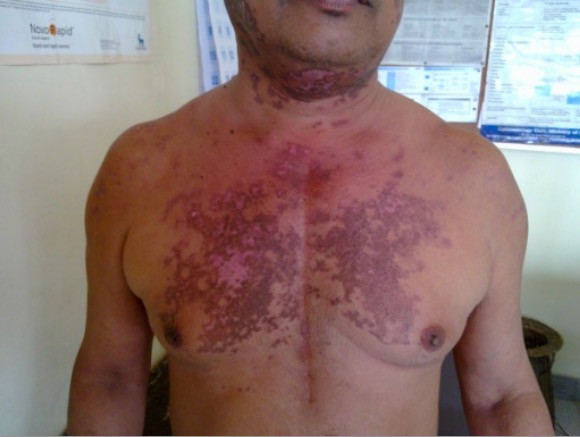Playlist
Show Playlist
Hide Playlist
Differential Diagnosis for Systemic Lupus Erythematosus (SLE)
-
Slides SLE.pdf
-
Reference List Rheumatology.pdf
-
Download Lecture Overview
00:01 So we've got a lot more antibodies here that have been tested. 00:04 Number one, the double stranded DNA and the Anti-Smith antibodies. 00:08 Now these tests are very specific for systemic lupus erythematosus and really just clenched our diagnosis of SLE. 00:15 In addition, those are tests you would not find in drug induced lupus. 00:19 In contrast, the anti-histone antibody; the next one in our list, is very specific for drug induced lupus. 00:25 So that pattern is really helping us to say that this is SLE not DIL. 00:30 Next stop is the anti-U1 RNP or ribonucleoprotein test. 00:35 This is a test specific for mixed connective tissue disease. 00:39 Now remember, mixed connective tissue disease is this constellation of signs and symptoms common to both lupus, polymyositis, rheumatoid arthritis, and systemic sclerosis. 00:49 Patients with MCTD will have features of all of those conditions all mixed together into one presentation. 00:56 So once we get the anti-U1 RNP test which is 100% present in patients with MCTD we can safely take that diagnosis off of our list. 01:06 Now, remember that our patient had a positive rheumatoid factor which could've stirred us toward thinking about rheumatoid arthritis. 01:13 Well, that test is modestly sensitive and modestly specific but the anti-citric citrullinated peptide which is the next one in our list, is very specific and sensitive for rheumatoid arthritis. 01:25 So, with that negative lab test we can also take RA off our list. 01:29 I'd also like to just highlight the C3 and C4 levels. 01:32 Often times hypocomplementemia is an indication of the severity of disease in lupus. 01:38 And in particular it suggest that there may be significant renal involvement. 01:42 Alright, we're moving through our list here. 01:45 The next stop on our extensive list is the fluorescent treponemal antibody absorption test or FTA-ABS. 01:51 Now, you'll remember that our patient had a positive VDRL so you might be thinking, "Oh my gosh, our patient has syphilis." Well, that's a very non-specific test; the VDRL like an RPR. 02:04 Once you see a positive test there, it's important to get confirmatory testing and that's what the FTA-ABS is. 02:10 This is a treponemal specific antigen test. And importantly in our case that test was negative. 02:16 A VDRL while it is sensitive for detecting syphilis, it's often falsely positive in patients with lupus. 02:23 So it's important to do that subsequent testing. 02:25 Next stop, it's always too good to check for hepatitis B surface antigen and surface antibody testing especially when we were thinking about polyarteritis nodosa. 02:34 And again, this just solidifies she does not have Hep B and it's even less likely to have polyarteritis nodosa. 02:40 At this point our next steps would probably be to check a protein to creatinine ratio to really get a census to how significant the renal involvement is and likely we would get a renal biopsy as well. 02:53 Probably with her evidence of an enlarged cardiac silhoutte and concerns about serositis, I'd probably recommend getting an echocardiogram as well to further characterize her pericardial disease. 03:04 Alright, either way, with all of that data we can safely exclude drug-induced lupus. 03:09 Remember she had that negative anti-histone test. 03:12 We can exclude PAN by virtue of leukopenia rather than leukocytosis, the lung involvement which conflicts with PAN, the very high ANA titers which you wouldn't see with PAN, the hypocomplementemia, and of course the negative Hep B serologies. 03:28 PAN is off the table. Rheumatoid arthritis, again despite the positive rheumatoid factor, we have a negative CCP and features that really go along with lupus more than RA, so that one's gone. 03:39 And as I said, syphilis is off due to the negative specific treponemal testing. So lupus it is. 03:45 So let's talk in more detail about some of the complications you might see in patients with lupus.
About the Lecture
The lecture Differential Diagnosis for Systemic Lupus Erythematosus (SLE) by Stephen Holt, MD, MS is from the course Connective Tissue Diseases.
Included Quiz Questions
Which of the following antibodies is most specific for systemic lupus erythematosus?
- Anti-Smith antibody
- Antinuclear antibody
- Antihistone antibody
- Anti-B2 glycoprotein antibody
- Anti-SSA antibody
Which of the following antibodies is most specific for mixed connective tissue disease?
- Anti-U1 RNP antibody
- Antinuclear antibody
- Anti-dsDNA antibody
- Anti-Jo-1 antibody
- Anti-Mi-2 antibody
Customer reviews
5,0 of 5 stars
| 5 Stars |
|
1 |
| 4 Stars |
|
0 |
| 3 Stars |
|
0 |
| 2 Stars |
|
0 |
| 1 Star |
|
0 |
Well set out, well explained lecture giving high yield information on the subject matter.




